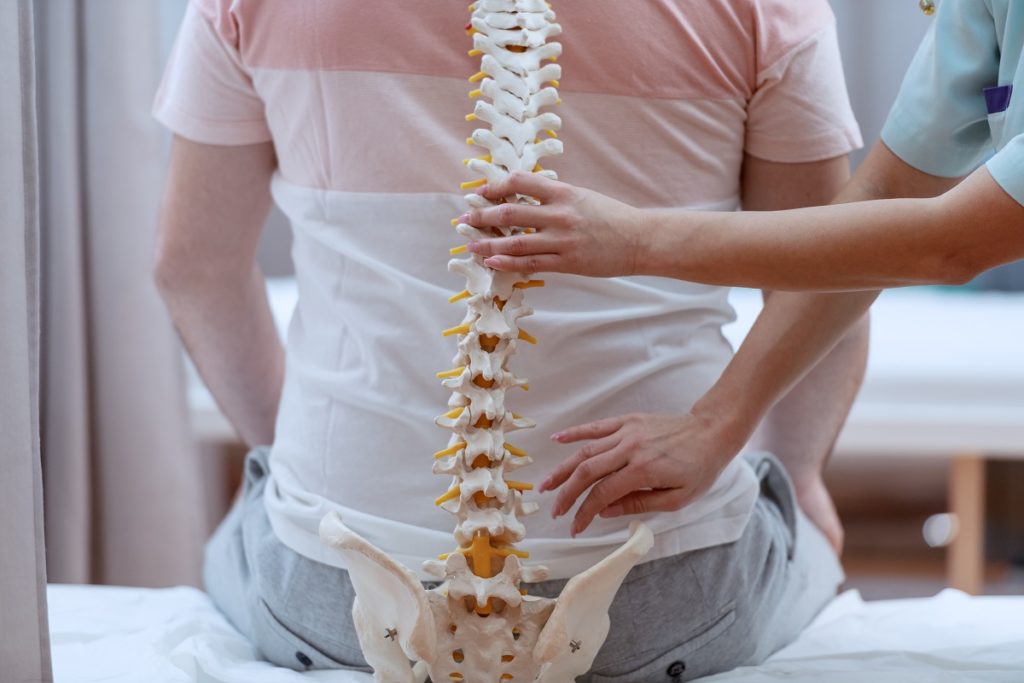It is unfortunate that the average person knows very little about the intricate makeup of the spinal column and the vertebra. But if you incur a spinal injury, it can impact your health in many ways. Paralysis, numbness, and severe pain are just the tip of iceberg. Oh, and you can even die or be maimed for life if the problem is severe enough!
After my recent monthly chiropractic adjustment, I mentioned to my chiro how limber I felt. For some unknown reason, I was less angry at life and wondered out loud why that might be. He simply smiled and explained that the spine is a frequent hiding place for some of our negative, destructive feelings and emotions. That’s when he suggested that I should write a blog post on this subject.
Needless to say, no sooner had I returned from my appointment than did a little research. I found many interesting facts that showed his statement is 100 percent true. But I then wondered how many of my readers still think that chiropractic adjustments are only for easing back pain—or, for that matter, just a bunch of quackery!
As you will see in my research below, knowing more about the components of the spinal column and how they work can substantially improve your life. My chiropractor shared the astounding fact that the spinal column holds onto our negative feelings and emotions. Fortunately, there are specially trained practitioners, generally chiropractors, who are able to detect and treat negative emotions by using the information they find in the vertebra of the spinal column.
Do wonders ever cease?
Some Basics About the Spinal Column
My primary certification is within the study of nutrition, but I nevertheless love all things regarding the mind and body, and I take special interest in other areas of health and well-being. In this case I simply dug deep and found numerous articles from which I constructed this article. I hope this information helps relieve those pesky moods and feelings we all have from time to time. Thanks to the many people who have contributed to this research.
The Mayfield Clinic offers one of the least complicated spinal overviews I found. If you’re not familiar with the spinal column, I recommend doing a quick review of the anatomical images they provide before you continue reading. The article explains that vertebrae are typically 33 individual bones, but they can range from 32 to 34. These bones are cushioned with a disc between each vertebra. As the quote underneath Figure 4 explains: “Discs are made of a gel-filled center called the nucleus and a tough fibrous outer ring called the annulus. The annulus pulls the vertebrae bones together against the resistance of the gel-filled nucleus. The vertebrae are interlocked with each other to form the spinal column.”
One of the most common disc injuries is when the gel that cushions each disc is displaced and/or damaged. This may cause the disc to become herniated, which can cause untold pain. In such cases, the discs are often surgically fused together, but this procedure is not always a success. Since I have a relatively serious disc injury, I’ve chosen to have my chiropractor adjust it about once a month. I also take extra care to use the best quality anti-inflammatory and pain-relieving supplements (which I will list at the bottom of this blog post).
Understanding the Components of the Spinal Column
Healthline offers short, easy-to-read descriptions of the five sections of the vertebrae, which I quote in full here:
- Cervical: The seven cervical vertebrae are those that are closest to the skull. The first is known as the atlas because the skull rests on it. The name comes from the myth of the Greek titan who bore the world on his shoulders. The second also has a special name: the axis. It has a special shape that allows the head to turn from side to side.
- Thoracic: The 12 thoracic vertebrae are where the ribs attach to the spine.
- Lumbar: The five lumbar vertebrae are among the largest and do much of the work of supporting the body’s weight.
- Sacral: This section has only one bone: the sacrum. Although considered one bone, it is actually comprised of five vertebrae fused together. The sacrum is part of the pelvis.
- Coccygeal: This section is similar to the sacral. It contains a single bone, the coccyx (tailbone), which is made up of three to five fused vertebrae.
Understanding the Numbering System of the Vertebrae
Now let’s discuss why each vertebra has its own letter and number. If you review Figure 2 in the article from the Mayfield Clinic, you’ll note that the first four regions of the spinal column are identified with a letter: C for cervical, T for thoracic, L for lumbar, and S for sacral. Each letter is further divided into numbers. These letters and numbers correspond to the position of the vertebrae along the spinal column.
Listed below are the details of this intricate spinal and vertebra configuration.
Cervical vertebrae: 7 bones numbered C1 through C7
Thoracic vertebrae: 12 bones numbered T1 through T12
Lumbar vertebrae: 5 bones numbered L1 through L5
Sacrum vertebrae: 5 bones numbered S1 through S5
(The coccyx is one bone only and is therefore not numbered.)
This information is vitally important because understanding the basics of the spinal column and vertebrae structure may help you find a specially trained doctor who can work with you using what is known as NET (neuro emotional technique). Chiropractors and practitioners with certification and training in NET know which vertebrae corresponds to which negative feeling or emotion, and they are therefore able to adjust the correct area of the spinal column to induce release.
Tell Me More About NET
NET is best explained in depth at NETMindBody.com. But the basics of this therapy involve weaving together acupuncture, chiropractic, and the mind-body relationship. NET was created by Dr. Scott Walker to help release emotions that are locked in the body and which are often related to a stressful event. In the simplest of terms, NET can be explained as a mind-body pattern that includes the organ, its associated emotions, its energy meridian, and its nerve connection to the spine. One way to clear the pattern or emotional issue is to identify the issue and then access it gently by tapping on the vertebrae that corresponds to the energy meridian and the organ holding the imbalance. Below is a list below of the specific areas in the vertebrae that can hold these emotions. Your chiropractor may be trained in this technique, so be sure to ask.
Once again, I encourage you to visit NETMindBody.com for videos and superb information that will help give you a fuller understanding of this unique treatment.
Below is a list of organs along with corresponding vertebra and symptoms. A comprehensive chart with much more information is available from your NET chiropractor/practitioner. (If you are a chiropractor/practitioner contemplating certification, the chart will no doubt be part of the training.)
Basic List of the Organs with Their Corresponding Vertebra and Symptoms
(Note: the information in parenthesis relates to children’s symptoms.)
-
-
- Stomach (T8, 10, 12): Over sympathetic (feel sorry)
- Spleen (T1, 5, 9) and Pancreas (T5): Low self-esteem (doesn’t feel good about themselves)
- Large intestine (L5): Dogmatically positioned (stuck)
- Left lung (T1, 8, L2) and Right lung (T2, 9, L3): Grief (sad)
- Bladder (L5):Paralyzed will (can’t do something that you want to)
- Kidney (T1, 5, 8): Fear (scared)
- Gallbladder (T4): Resentment (mad)
- Liver (T2, 5, 8): Anger (upset)
- Small intestine (L5): Lost, vulnerable (easy to hurt, helpless)
- Heart (T2, 8, 12): Frightfully overjoyed (too happy)
- Thyroid (C1, 4, 7): Muddled instability (not sure)
- Adrenals (T7, 9, 11): Muddled instability (not sure)
-
The group below all relate to non-thinking, non-emotive, not showing feelings:
-
-
- Prostrate: L5
- Testicles: Bilateral sacroiliac joints
- Ovaries: L3, 5
- Uterus: coccyx
- Pituitary: C2, 5, T1
-
Locating a NET Practitioner
There are three levels of NET certification. You can find a certified provider here.
- Level I: Completed certification program and attends ongoing classes.
- Level II: Level I plus extra training with an advanced practical exam.
- Level III: Level II plus extra training with an advanced written exam.
Now here are some of my favorite recommended whole food supplements:
My Favorite Whole Food Supplements for Disc Degeneration
My Favorite Whole Food Supplements for Back Pain
My Favorite Whole Food Supplements for Mental Calming
Two of My Favorite Healing Recipes
The first recipe below is a collagen-rich bone broth for muscle, body, and mind. The second is a raw milkshake with bone-building and mind-calming ingredients.
Piggy and Chicken Feet Basic Bone Broth
—A Traditional Cook original recipe I developed for my blog post “Muscle Memory: What You Need to Know.”
I can almost hear you saying eeew (smile), but don’t let the ingredients in this robust high-gelatin broth scare you off. I get my piggy and chicken feet shipped locally from Ranch Foods Direct. However, you can also find a supplier in the Weston A. Price Shopping Guide (or their Find Real Food app). This particular combination is one most dense gelatinous broths you can make—even thicker than Jell-O!
Ingredients
1 pig foot (mine was approximately 10-inches long)
1 package (about 1 lb.) chicken feet, cleaned and with skin left on
1 cup vinegar
1 large yellow onion, chopped
Raw leftover veggies (except beets), if you have them
2 tablespoons apple cider vinegar
Instructions
- Place pig and chicken feet in a small oval pan (such as this one).
- Add vinegar and fill pan with spring water.
- Carefully place pan in refrigerator and allow feet too soak through the night.
- The next morning, rinse well and transfer to a large oval slow cooker.
- Add onion and other raw leftover veggies (if using).
- Fill to top with spring water, add apple cider vinegar. Cover and place on high setting for approximately 1 hour.
- Turn slow cooker to low setting. Simmer for approximately 12 hours. (I generally start mine at 5:00 to 6:00 in the morning, and it’s nicely cooked by 6:00 in the evening.)
- Allow broth to cool. Remove pig’s foot with a slotted spoon and save to eat another time. (It’s quite tasty with a bit of salt and pepper.)
- Remove chicken feet with the slotted spoon. (These can be cooked a second time until extremely soft, then crushed for use in your homemade dog or cat food.)
- Strain broth into a large glass bowl and place in refrigerator overnight.
- Next morning you will have a thick, healthy broth. I freeze mine in 1-pint BPA-free plastic containers for later use in my beans or other soups (instead of water). I also heat it up in a cup, add finely minced garlic and some salt and pepper, and serve it with my meal.
Raw Milkshake
—A Traditional Cook original recipe (please give credit when using). This milkshake is rich in calcium and contains bone-building, mind-calming ingredients.
Ingredients
⅓ cup raw milk (recommended) or whole organic milk
1½ cups quality vanilla ice cream (see recommendations here)
½ teaspoon real vanilla from the Vanilla Queen
Optional additions:
1 tablespoon Calcifood Powder (to augment bone health and calm the mind) or Cyrofood Powder (a powerful multivitamin supplement)
¼ cup fresh blueberries, strawberries, pitted cherries, or other fresh (not frozen) fruit
½ banana (if using, go easy on bananas as they are high in sugar)
½ teaspoon or to taste carob powder (for a chocolatey taste that won’t stimulate the adrenals)
Instructions
- Place all ingredients in a Vitamix or blender.
- Gently mix until all ingredients are combined (be careful not to overmix).
- Pour into tall, fancy milkshake glasses and enjoy.
Afterthoughts from the Traditional Cook
Well Dear Readers,
We’ve come to the end of some great information about back pain and mind healing. Now comes the good part of doing the do! Yes, it is hard to reread an article, but here you will learn about great concentrated food supplements, not just plain vitamins. You can also get busy and visit the Weston A. Price Foundation where you can find some of the most nutrient-dense recipes you’ll ever encounter.
If you don’t think you got in ya to do all that, please read my blog post “Conscious Autosuggestion.” That, dear readers, will put on the road to get whatever you desire.
Many blessings,
Maria Atwood, CNHP
Disclaimer from Maria Atwood, CNHP: I am a Certified Natural Health Professional, CNHP, not a medical doctor. I do not diagnose, prescribe for, treat, or claim to prevent, mitigate, or cure any human diseases. Please see your medical doctor or health practitioner prior to following any recommendations I make in my blog posts or on my website.
Images from iStock/fizkes (main), photovs (soup), dusanpetkovic (spine), Viorel Kurnosov (happy woman).




